Candidates can download NCERT Exemplar Class 11 Physics Chapter 6 from this page. The exemplar has been provided by the National Council of Educational Research & Training (NCERT) and the candidates can check it from below for free of cost. It contains objective, very short answer type, short answer type, and long answer type questions. Along with it, the answer for each question has also been provided. From the NCERT Exemplar Class 11 Physics Chapter 6, candidates can understand the level and type of questions that are asked in the exam.
NCERT Exemplar Class 11 Physics Chapter 6 System of Particles and Rotational Motion
NCERT Class 11 Physics Chapter 6 is for System of Particles and Rotational Motion. The type of questions that will be asked from NCERT Class 11 Physics Chapter 6 are displayed in the below provided NCERT Exemplar Class 11 Physics Chapter 6. With the help of it, candidates can prepare well for the examination.
Also Check: NCERT Solutions for Class 11 Physics
Multiple Choice Questions (MCQ I)
- For which of the following does the centre of mass lie outside the body ?
(a) A pencil
(b) A shotput
(c) A dice
(d) A bangle - Which of the following points is the likely position of the centre of mass of the system shown in Fig. 7.1?
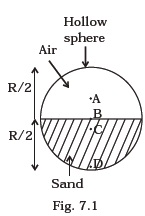
(a) A
(b) B
(c) C
(d) D - A particle of mass m is moving in yz-plane with a uniform velocity v with its trajectory running parallel to +ve y-axis and intersecting z-axis at z = a (Fig. 7.2). The change in its angular momentum about the origin as it bounces elastically from a wall at y = constant is:
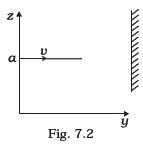

- When a disc rotates with uniform angular velocity, which of the following is not true?
(a) The sense of rotation remains same.
(b) The orientation of the axis of rotation remains same.
(c) The speed of rotation is non-zero and remains same.
(d) The angular acceleration is non-zero and remains same. - A uniform square plate has a small piece Q of an irregular shape removed and glued to the centre of the plate leaving a hole behind (Fig. 7.3). The moment of inertia about the z-axis is then
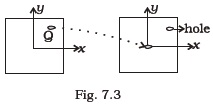
(a) increased
(b) decreased
(c) the same
(d) changed in unpredicted manner. - In problem 7.5, the CM of the plate is now in the following quadrant of x-y plane,
(a) I
(b) II
(c) III
(d) IV - The density of a non-uniform rod of length 1 m is given by ρ (x) = a(1+bx2) where a and b are constants and o ≤ x ≤1. The centre of mass of the rod will be at
(a) 3 (2 + b) / 4 (3 + b)
(b) 4 (2 + b) / 3 (3 + b)
(c) 3 (3 + b) / 4 (2 + b)
(d) 4 (3 + b) / 3 (2 + b) - A Merry-go-round, made of a ring-like platform of radius R and mass M, is revolving with angular speed ω . A person of mass M is standing on it. At one instant, the person jumps off the round, radially away from the centre of the round (as seen from the round). The speed of the round afterwards is
(a) 2ω
(b) ω
(c) ω / 2
(d) 0
Multiple Choice Questions (MCQ II)
- Choose the correct alternatives:
(a) For a general rotational motion, angular momentum L and angular velocity ω need not be parallel.
(b) For a rotational motion about a fixed axis, angular momentum L and angular velocity ω are always
parallel.
(c) For a general translational motion , momentum p and velocity v are always parallel.
(d) For a general translational motion, acceleration a and velocity v are always parallel. - Figure 7.4 shows two identical particles 1 and 2, each of mass m, moving in opposite directions with same speed v along parallel lines.
At a particular instant, r1 and r2 are their respective position vectors drawn from point A which is in the plane of the parallel lines . Choose the correct options :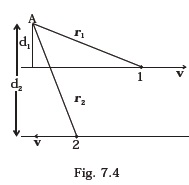
(a) Angular momentum I1 of particle 1 about A is l1 = mvd1 ⊙
(b) Angular momentum l2 of particle 2 about A is I2 = mvr2 ⊙
(c) Total angular momentum of the system about A is I = mv(r1 + r2) ⊙
(d) Total angular momentum of the system about A is I = mv(d2 − d1)⊗
⊙ represents a unit vector coming out of the page.
⊗ represents a unit vector going into the page. - The net external torque on a system of particles about an axis is zero. Which of the following are compatible with it ?
(a) The forces may be acting radially from a point on the axis.
(b) The forces may be acting on the axis of rotation.
(c) The forces may be acting parallel to the axis of rotation.
(d) The torque caused by some forces may be equal and opposite to that caused by other forces. - Figure 7.5 shows a lamina in x-y plane. Two axes z and z′ pass perpendicular to its plane. A force F acts in the plane of lamina at point P as shown. Which of the following are true? (The point P is closer to z′-axis than the z-axis.)
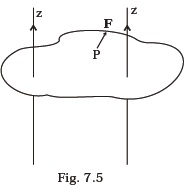

- With reference to Fig. 7.6 of a cube of edge a and mass m, state whether the following are true or false. (O is the centre of the cube.)
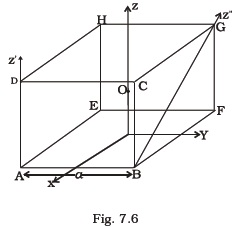
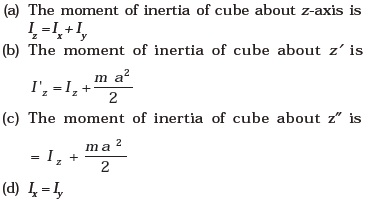
Very Short Answer Type Questions
- The centre of gravity of a body on the earth coincides with its centre of mass for a ‘small’ object whereas for an ‘extended’ object it may not. What is the qualitative meaning of ‘small’ and ‘extended’ in this regard?
For which of the following the two coincides? A building, a pond, a lake, a mountain? - Why does a solid sphere have smaller moment of inertia than a hollow cylinder of same mass and radius, about an axis passing through their axes of symmetry?
- The variation of angular position θ , of a point on a rotating rigid body, with time t is shown in Fig. 7.7. Is the body rotating clock-wise or anti-clockwise?
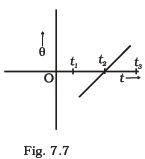
- A uniform cube of mass m and side a is placed on a frictionless horizontal surface. A vertical force F is applied to the edge as shown in Fig. 7.8. Match the following (most appropriate choice
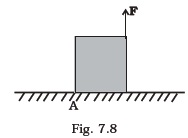

- A uniform sphere of mass m and radius R is placed on a rough horizontal surface (Fig. 7.9). The sphere is struck horizontally at a height h from the floor. Match the following:
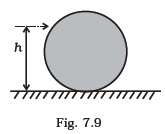

Short Answer Type Questions
- The vector sum of a system of non-collinear forces acting on a rigid body is given to be non-zero. If the vector sum of all the torques due to the system of forces about a certain point is found to be zero, does this mean that it is necessarily zero about any arbitrary point?
- A wheel in uniform motion about an axis passing through its centre and perpendicular to its plane is considered to be in mechanical (translational plus rotational) equilibrium because no net external force or torque is required to sustain its motion. However, the particles that constitute the wheel do experience a centripetal acceleration directed towards the centre. How do you reconcile this fact with the wheel being in equilibrium?
- How would you set a half-wheel into uniform motion about an axis passing through the centre of mass of the wheel and perpendicular to its plane? Will you require external forces to sustain the motion?
- A door is hinged at one end and is free to rotate about a vertical axis (Fig. 7.10). Does its weight cause any torque about this axis? Give reason for your answer
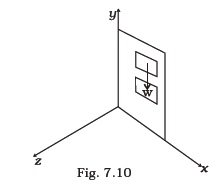
- (n-1) equal point masses each of mass m are placed at the vertices of a regular n-polygon. The vacant vertex has a position vector a with respect to the centre of the polygon. Find the position vector of centre of mass
Long Answer Type Questions
- Find the centre of mass of a uniform (a) half-disc, (b) quarter-disc.
- Two discs of moments of inertia I1 and I2 about their respective axes (normal to the disc and passing through the centre), and rotating with angular speed ω1 and ω2 are brought into contact face to face with their axes of rotation coincident.
(a) Does the law of conservation of angular momentum apply to the situation? why?
(b) Find the angular speed of the two-disc system.
(c) Calculate the loss in kinetic energy of the system in the process.
(d) Account for this loss. - A disc of radius R is rotating with an angular speed ωo about a horizontal axis. It is placed on a horizontal table. The coefficient of kinetic friction is μk.
(a) What was the velocity of its centre of mass before being brought in contact with the table?
(b) What happens to the linear velocity of a point on its rim when placed in contact with the table?
(c) What happens to the linear speed of the centre of mass when disc is placed in contact with the table?
(d) Which force is responsible for the effects in (b) and (c).
(e) What condition should be satisfied for rolling to begin?
(f) Calculate the time taken for the rolling to begin. - Two cylindrical hollow drums of radii R and 2R, and of a common height h, are rotating with angular velocities ω (anti-clockwise) and ω (clockwise), respectively. Their axes, fixed are parallel and in a horizontal plane separated by (3R + δ ) . They are now brought in contact (δ → 0).
(a) Show the frictional forces just after contact.
(b) Identify forces and torques external to the system just after contact.
(c) What would be the ratio of final angular velocities when friction ceases? - A uniform square plate S (side c) and a uniform rectangular plate R (sides b, a) have identical areas and masses (Fig. 7.11).
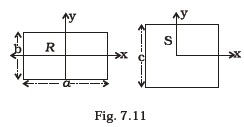
Show that
(i) IxR / IxS < 1;
(ii) IyR / yS > 1;
(iii) IzR / IzS > 1. - A uniform disc of radius R, is resting on a table on its rim.The coefficient of friction between disc and table is μ (Fig 7.12). Now the disc is pulled with a force F as shown in the figure. What is the maximum value of F for which the disc rolls without slipping ?

Click here to download the NCERT Exemplar Class 11 Physics Chapter 6 System of Particles and Rotational Motion.
Answers to Multiple Choice Questions










Physics Chemistry Maths Biology
To get study material, exam alerts and news, join our Whatsapp Channel.
